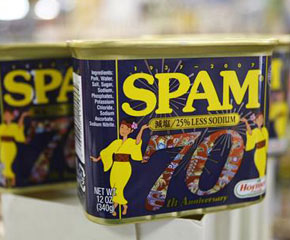Residents of the southern Japanese island of Okinawa might like their tofu and other Japanese favourites, but they are just as likely to tuck into fast food burgers and other dishes first made familiar by American troops.
“We’ve been used to American food from an early age and people think it’s just as Okinawan as ‘chanpuru’ (stir fry),” said Yasuyuki Takaesu, master chef at a restaurant in the Okinawa capital of Naha that serves traditional fare such as crunchy “mimiga” (pig ears) and “rafuti” (flavoured stewed pork).
Okinawa was occupied by the US military from Japan’s 1945 defeat in World War Two until 1972, and remains host to the bulk of US troops in Japan under a bilateral security treaty.
Spam and ‘taco curry’
Such fare is familiar to the American palate, but Okinawa dishes that prepare well-known ingredients with a local twist can cause both mainland Japanese and Westerners to do a double-take.
Take the selection of “onigiri” – Japanese rice balls wrapped in seaweed – sold in convenience stores.
Markets selling products from pig’s feet to colourful fresh fish also display rows of canned Spam processed meat – which can be purchased as souvenirs at shops frequented by tourists.“This kind of food was brought in by the Americans as emergency aid after the war and we’ve all eaten it since we were little, so it’s more popular here than on the mainland,” said a white-haired woman selling Spam at a Naha market.
Equally popular among Okinawans is “taco rice”, a dish in which a spicy meat filling usually found inside a taco is heaped on a mound of rice with lettuce, tomatoes and cheese.
Decades of an Americanised diet, Okinawa health officials say, is partly responsible for making islanders fatter, more prone to heart disease and likely to die sooner than either their elders or compatriots in many parts of the mainland.

